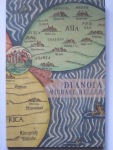
The Scottish philosopher Sir William Hamilton proposed the term dianoiology for that portion of logic which deals with dianoetic processes of the mind: the thinking through of ideas. For a writer this may well involve what Michael Heller refers to as the ‘breaking apart’ of ‘clods of what was named’ because after all language is the ‘hardest / of earths, each word narrowing…’. So many of these poems in Dianoia deal with stasis and movement and they are deeply moving testimony to an artist who has spent a lifetime trying to let stillness convey fluidity.
In ‘Visiting Brigflatts with Ric’, written in memory of Ric Caddel, the opening lines plunge the reader into a memory:
‘Your car chugging up the pass
into snow’s unseasonal bursts,
all the while sun shining overhead,
then a plunge down to Bunting’s grave,
stone of Quaker plainness…’
The movement of that opening line followed by the unusual nature of the weather hardens out into ‘stone’ which in turn will become ‘austerity of row upon row.’ The picture we are given of Ric Caddel is of ‘an elm’s rooted trunk / or northern stone pillar’ but the metamorphosis of this poem’s language, the stasis of what is memorialised, is given fresh movement in the last line with ‘currents animating earth’. And there we have it! The poet at work!
In ‘Lecture’, we move between an account of the German artist Max Beckmann’s painting ‘Tot’ and the Number 30 London bus being blown up in July 2005. We move between the Japanese poet Bashō who ‘travels along paths and byways’ producing ‘spontaneous evocations in poetic form, haiku, linked haiku’ and the American poet George Oppen who writes of a highway accident with ‘The wheels of the overturned wreck / Still spinning – ’. As Heller looks closely at the photographs of both the London bombing and of a bus blown up is Israel he notes
‘No need here to go into “visual” languages, semiotics, etc. We’re talking about what gets communicated across the special loneliness between you and me and I and it.’
Referring again to Bashō and his journal writings in Narrow Road to the North Heller gives us one aspect of the artist caught in a moment: ‘that impression of spontaneity is part of the art of it’. He quotes the short piece of Bashō which evokes the memory of the heroic death of Lord Sanemori, an ageing warrior who dyed his hair to disguise his age, and whose helmet was carried to the shrine that the Japanese poet has just passed:
‘I am awestruck
To hear a cricket singing
Underneath the dark cavity
Of an old helmet.’
The living quality of stillness is central to Michael Heller’s art and in the opening page of ‘Lecture’ he focuses upon his own walking in which he is accompanied by all that makes him who he is. He walks with Bashō, ‘stopping at a shrine, experiencing awe and reverence, the surround of mountain peak and foliage, the pines he likened to solitary figures’. The image from the Japanese is part of who he is as he moves through a living world of gone things. Focusing on the July bombings in London he writes of the world of the here-and-now and how it impinges upon who we are:
‘The self. That’s what got me going here, the self alone against murderousness, the sudden “nearness” (I don’t know how else to put it) to random murder perpetrated by others against innocents.’
The Number 30 is the bus that often carried the poet from Islington to Bloomsbury, to the British Museum. ‘Had we arrived a day earlier…’. The sense of how we see ourselves in relation to the world around us is central to the vision:
‘…My sense that A can morph into B,
tenuous nets of companionship, that we ride
like they ride who elsewhere are killed.’
Heller writes that ‘We are exposed / to the possibility of unplanned ruin’ and he seems partly to echo Paul Auster’s comment at the opening of In the Country of Last Things:
‘When you live in the city, you learn to take nothing for granted. Close your eyes for a moment, turn around to look at something else, and the thing that was before you is suddenly gone. Nothing lasts, you see, not even the thoughts inside you. And you mustn’t waste your time looking for them. Once a thing is gone, that is the end of it.’
The bitterness of the narrator in this apocalyptic novel from 1987 is, however, far different from Michael Heller’s determination to make the moment live, to give stasis currency and it seems appropriate to conclude not only with that image of ‘currents animating earth’ but also with the short poem Ric Caddel wrote for John Riley, the Leeds poet who was murdered in 1978:
‘What in the world we see
is what’s important. There
the days seemed shorter and our hearts
spun with the compass under
trees, magnificent pointers
out of galaxies. Continental drift,
an appointment we were late for,
an old friend missed.’
My review of The Poetry and Poetics of Michael Heller, ed. Curley & Kimmelman, has just appeared in the current issue of PN Review.
Ian Brinton 7th May
